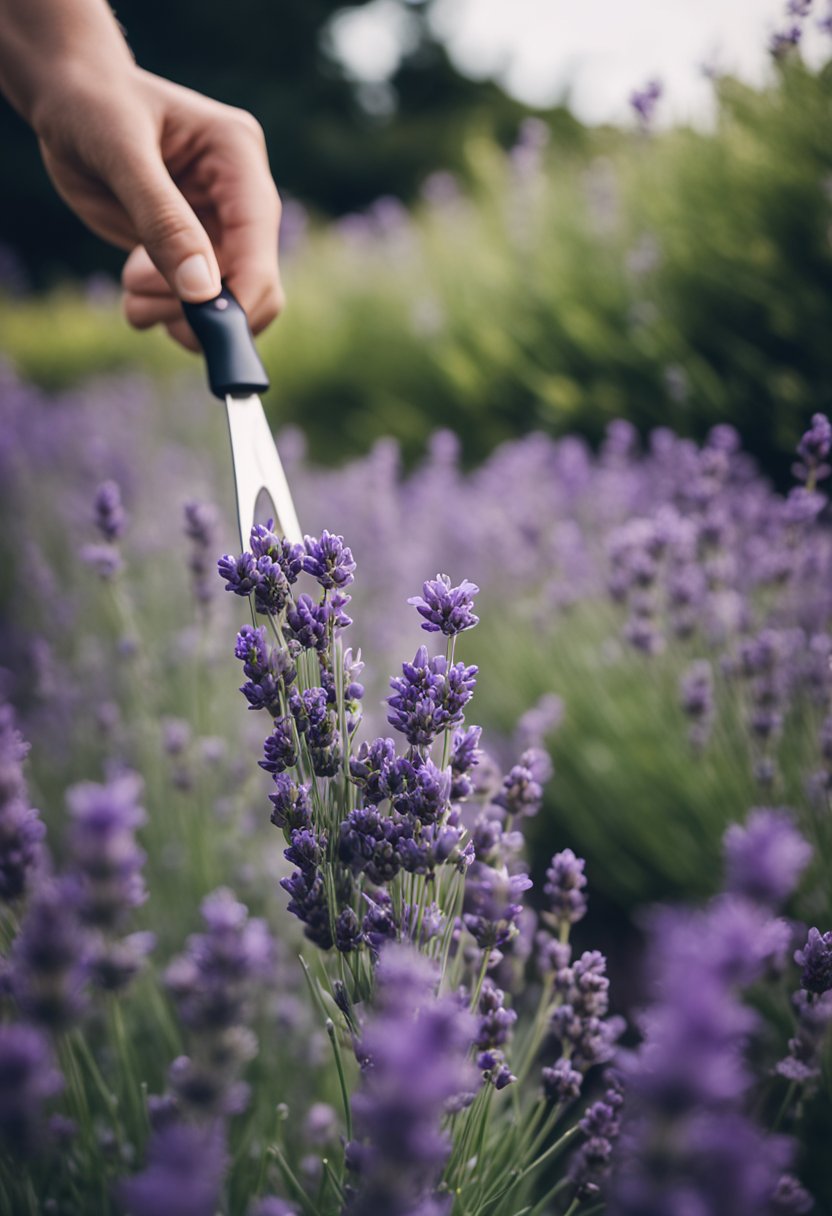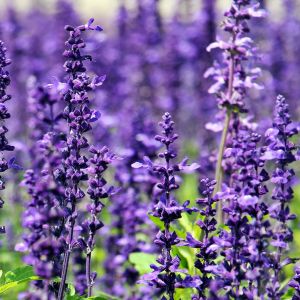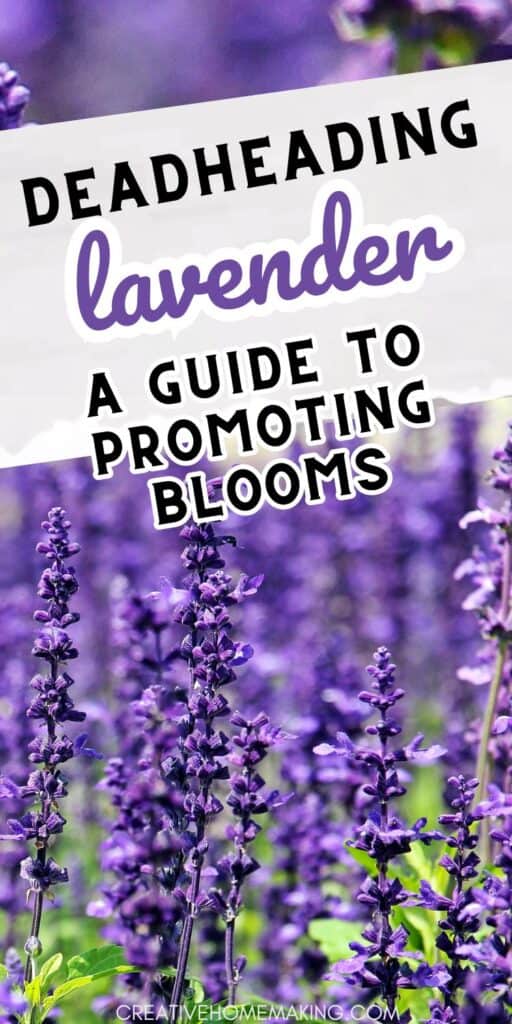Deadheading lavender is an important task to keep your garden looking beautiful throughout the growing season.
This post may contain affiliate links.
This process involves removing spent blooms from the lavender plant to encourage new growth and more blooms. Deadheading is a simple and easy task that can be done by anyone, even those new to gardening.
Lavender is a popular plant for many gardeners due to its beautiful blooms and fragrant scent. However, once the blooms start to fade, they can make the plant look messy and unkempt.
Deadheading lavender is a great way to keep your plants looking neat and tidy while also promoting healthy growth.
By removing the spent blooms, you are telling the plant to put its energy into producing new growth and more blooms, rather than trying to produce seeds.
Related Article: Growing Lavender in Pots: Tips and Tricks for a Beautiful Garden
Deadheading lavender can be done throughout the growing season, as soon as the blooms start to fade. It’s important to use sharp, clean shears when deadheading to prevent damaging the plant.
By deadheading regularly, you can extend the blooming period of your lavender plants and keep your garden looking beautiful all season long.
Understanding Deadheading
Deadheading is the process of removing spent flowers from plants to encourage new growth and more blooms. It’s a simple and effective way to keep your lavender healthy and looking its best.
Related Article: When Do Gardenias Bloom?
Benefits of Deadheading
Deadheading your lavender has several benefits. It helps to:
- Promote new growth: By removing spent flowers, you’re directing the plant’s energy towards new growth rather than seed production.
- Encourage more blooms: Deadheading can stimulate the plant to produce more flowers, resulting in a longer flowering season.
- Maintain plant health: Removing dead flowers can prevent disease and insect infestations, keeping your lavender healthy and strong.
When to Deadhead Lavender
The best time to deadhead your lavender is after the first flush of flowers has faded. This is usually in late spring or early summer. Simply pinch or cut off the spent flowers just above the first set of leaves.
If you want to encourage a second flush of flowers, deadhead again in late summer or early fall. This will give your lavender a chance to produce more blooms before the end of the growing season.
Related Article: How to Deadhead Zinnias: A Friendly Guide

The Deadheading Process
Deadheading is the process of removing spent flowers from a plant to encourage new growth and prolong blooming.
Deadheading lavender is an important task that will keep your plant looking healthy and beautiful. In this section, we will go over the tools you will need and how to properly deadhead lavender.
Tools for Deadheading
To deadhead lavender, you will need a few tools. The most important tool is a pair of sharp scissors or pruning shears. Micro-tip pruning snips are also a great option for deadheading lavender. Make sure your tools are clean and sharp to prevent damaging the plant.
How to Deadhead Lavender
The first step in deadheading lavender is to identify the spent flowers. These are the flowers that have already bloomed and are starting to wilt. They can be easily identified by their brown color and droopy appearance.
To deadhead the spent flowers, use your scissors or pruning shears to cut the stem just above the first set of leaves. This will encourage new growth and more blooms. Be sure to cut at an angle to prevent water from pooling on the cut surface.
If you have a large lavender plant, it may be helpful to deadhead in stages. This will prevent the plant from becoming stressed and ensure that it continues to bloom throughout the season.

Aftercare and Maintenance
After deadheading your lavender plants, it’s crucial to properly care for and maintain them to ensure optimal growth and health. Here are some tips on how to do so:
Watering and Fertilizing
Watering your lavender plants regularly is essential for their growth and overall health. Make sure to water them deeply once a week, especially during hot and dry weather. However, avoid overwatering as it can lead to root rot and other diseases.
Fertilizing your lavender plants can also help promote healthy growth and blooming. Use a balanced fertilizer with equal amounts of nitrogen, phosphorus, and potassium, and apply it once a month during the growing season.
Managing Pests and Diseases
Lavender plants are generally resistant to pests and diseases, but they can still be affected by some common issues. Here are some tips on how to manage them:
- Aphids: These tiny insects can suck the sap from lavender leaves and cause them to wilt and yellow. To manage them, spray your plants with a strong jet of water or use insecticidal soap.
- Spider mites: These pests can cause yellowing and browning of lavender leaves. To manage them, spray your plants with a mixture of water and neem oil.
- Root rot: Overwatering and poor drainage can lead to root rot, which can cause the plant to die. To manage it, make sure your plants are not sitting in water and avoid overwatering.
By following these aftercare and maintenance tips, you can ensure that your lavender plants remain healthy and vibrant year after year.
Lavender Varieties and Deadheading
When it comes to deadheading lavender, it’s important to know which variety you have. Deadheading is the process of removing spent flowers from a plant to promote new growth and extend the blooming season. Here are some tips for deadheading different lavender varieties:
English Lavender
English lavender, also known as true lavender, is the most commonly grown variety. It has a compact, bushy habit and produces fragrant, purple-blue flowers.
To deadhead English lavender, wait until the flowers have faded and then cut the stems back to just above the first set of leaves. This will encourage the plant to produce new growth and more flowers.
Two popular cultivars of English lavender are Hidcote and Munstead. Hidcote has deep purple flowers and a compact habit, while Munstead has lighter purple flowers and a more spreading habit. Both varieties are great for borders, containers, and dried arrangements.
Spanish and French Lavender
Spanish and French lavender are both members of the Lavandula stoechas species. They have a more open, airy habit and produce flowers in shades of pink, purple, and white.
To deadhead Spanish and French lavender, pinch off the spent flowers and a few inches of stem. This will encourage the plant to produce more flowers and prevent it from becoming too leggy.
One popular cultivar of Spanish lavender is Sharon Roberts, which has deep purple flowers and a compact habit. French lavender is often sold under the name Buena Vista and has pink-purple flowers and a more spreading habit.
Frequently Asked Questions
How do I properly deadhead Spanish lavender to encourage continuous blooming?
To deadhead Spanish lavender, you should remove the spent flower stems just above the first set of leaves below the flowers.
This will encourage the plant to produce more blooms and extend the blooming period. Be sure to deadhead regularly throughout the growing season to promote continuous blooming.
What’s the best way to deadhead lavender plants in pots?
Deadheading lavender plants in pots is similar to deadheading those in the ground. Simply remove the spent flower stems just above the first set of leaves below the flowers. Be sure to use clean, sharp pruning shears to avoid damaging the plant.
Should lavender be deadheaded during the winter months, and if so, how?
Lavender does not need to be deadheaded during the winter months as it is not actively growing or blooming during this time. However, if you notice any dead or damaged stems, you can prune them back to promote healthy growth in the spring.
What are the tips for deadheading lavender in the summer to promote growth?
To deadhead lavender in the summer, you should remove the spent flower stems just above the first set of leaves below the flowers.
This will promote new growth and encourage the plant to produce more blooms. It’s important to deadhead regularly throughout the growing season to keep the plant looking neat and tidy.
Can the flowers from deadheaded lavender be used for any purpose?
Yes, the flowers from deadheaded lavender can be used for a variety of purposes, including making potpourri, sachets, and lavender oil. Simply remove the flowers from the stem and use as desired.
What are the consequences of not pruning lavender regularly?
If lavender is not pruned regularly, it can become woody and leggy, with fewer blooms and less attractive foliage. Regular pruning helps to promote healthy growth, maintain the plant’s shape, and encourage continuous blooming.
Follow my lavender board on Pinterest.



